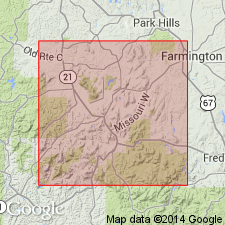
- Usage in publication:
-
- Musco group
- Modifications:
-
- First used
- Dominant lithology:
-
- [Granite]
- [Porphyry]
- AAPG geologic province:
-
- Midcontinent region
Summary:
Musco group (new). Briefly summarized in report by W.C. Hayes, Precambrian rock units in Missouri, p. 81, 82, 83 (table 1), this volume. New names are credited to Tolman and Robertson (in prep.) [1969, Missouri Div. Geol. Survey Water Res. Rpt. Inv., no. 44 (Contrib. to Precambrian Geol., no. 1)]. Includes Carver Creek granite porphyry, Buford granite porphyry, Munger granite porphyry, Slabtown granite, and Stono granite (all new). Believed to be older than Bevos group (new). Age is Precambrian.
Occurs in St. Francois Mountain area. Musco Creek is in Madison Co., southeastern MO.
Source: Modified from US geologic names lexicon (USGS Bull. 1350, p. 516).

- Usage in publication:
-
- Musco group
- Modifications:
-
- Principal reference
- Dominant lithology:
-
- Granite
- Porphyry
- AAPG geologic province:
-
- Midcontinent region
Summary:
Musco group. Present in St. Francois Mountains, southeastern Missouri. Divided into 5 units: Buford granite porphyry, Carver Creek granite porphyry, Munger granite porphyry, Slabtown granite, and Stono granite. Granites of Musco are usually fine-grained, porphyritic, range in color from red to dark shades of reddish-browns and purples with conspicuous greenish mottling due to presence of chlorite and epidote; phenocrysts are pink potash feldspar. Formed during earlier phase (of 2) of batholithic intrusion and appear to have differentiated in place. Older than Bevos group which formed during later phase of batholithic intrusion. Younger than Van East group. Age is Precambrian.
Named from exposures in area of Musco Creek, a southeasterly-flowing tributary of the St. Francis River, from Knob Lick to a point northwest of Frederickstown, Madison Co., MO. (Type locality not designated.)
[GNU remark (Feb. 16, 1990, USGS DDS-6; Denver GNULEX): Stratigraphic relationships of units of Musco not discussed in text; geologic map (plate 1) missing from library copy of report.]
[GNC remark (February 29, 2008): It appears that †Musco group has not been applied to these rocks since this publication. Considered abandoned.]
Source: Modified from GNU records (USGS DDS-6; Denver GNULEX).
For more information, please contact Nancy Stamm, Geologic Names Committee Secretary.
Asterisk (*) indicates published by U.S. Geological Survey authors.
"No current usage" (†) implies that a name has been abandoned or has fallen into disuse. Former usage and, if known, replacement name given in parentheses ( ).
Slash (/) indicates name conflicts with nomenclatural guidelines (CSN, 1933; ACSN, 1961, 1970; NACSN, 1983, 2005, 2021). May be explained within brackets ([ ]).

